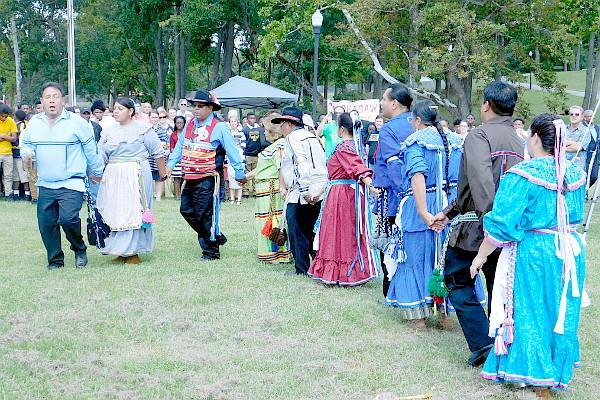
Photos by Sue Watson
Five men and five women from the Chickasaw Nation Dance Troupe in Ada, Oklahoma, perform ancient dances and songs. The Chickasaw believe their songs have been here on Earth since the beginning of time.
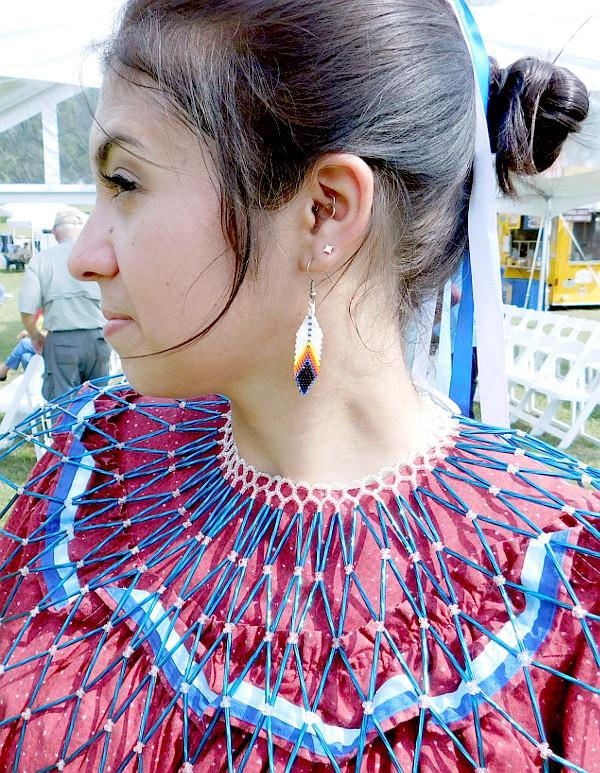
Monica Copeland, with the Chickasaw Dance Troupe, displays items of her attire which include earrings and a colorful collar.
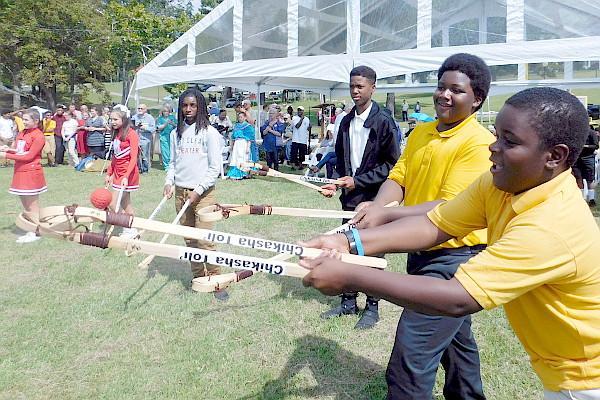
Local schoolchildren participated in a stickball demonstration and practice as part of the Chickasaw Celebration Friday.
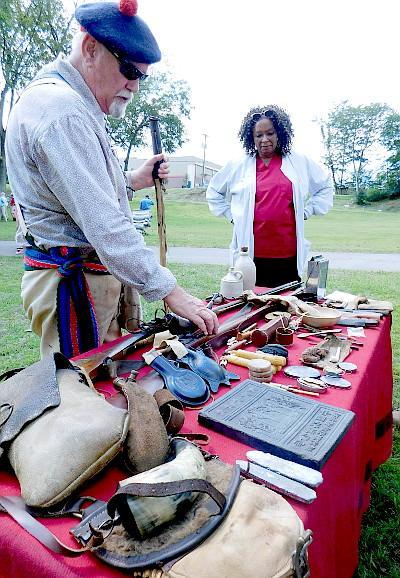
Jerry Beck displays items in his collection that were sold in trading posts during the days of the early settlers. Looking on is Jannie Luellen, nurse at Rust College.
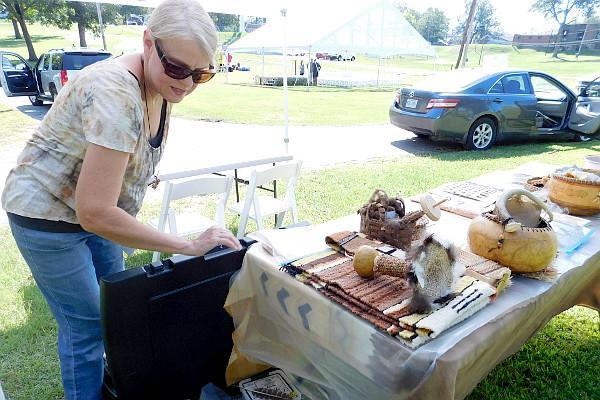
Photos by Sue Watson
Jeanette Stone, of Potts Camp, provides a display of fibers, natural dyes and fabrics she uses in her weave crafts.
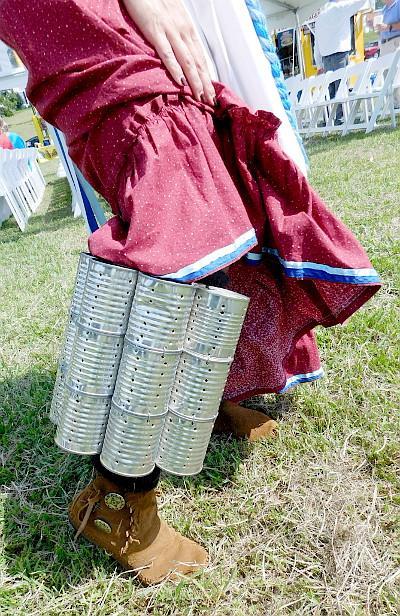
Chickasaw women wear shakers on their legs during stomp dances. The cans have smooth river rocks inside and they help keep the rhythm while the male dancers do the singing.
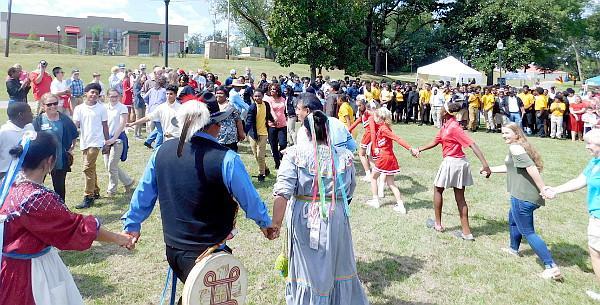
Local schoolchildren and adults join members of the Chickasaw Dance Troup in a Four Corners dance.
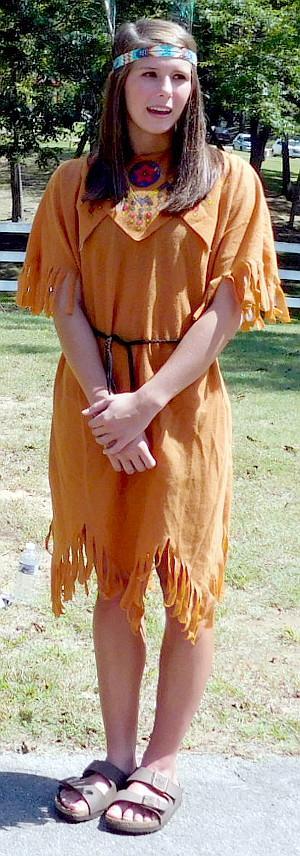
Photos by Sue Watson
Reenactors were stationed along the park trails wearing their costumes and telling their stories. (Above) Erin Lomenick portrays Princess Lakota during the Chickasaw Celebration. (Below) Alexa Ashmead portrays Susan Blair.
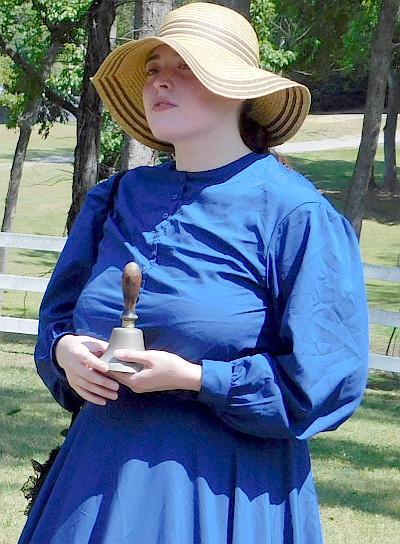
Chickasaw Celebration
The first Chickasaw Celebration held in Holly Springs was a great consciousness-raising event. Young, middle and old, and all races met to hear character actors tell stories of the settling of Holly Springs. They were also entertained by a Chickasaw Nation Dance Troupe and treated to a stickball demonstration.
The event was colorful and energizing, taking place in the historic Spring Hollow Park where the Chickasaw, before the settlers came, dipped their cups in the cool spring waters.
“Everybody got to join in, if they wanted to,” said Annie Perry of Tuscumbia, Ala.
She helped originate the Return, a celebration of the return of the Indians to the place where their ancestors left on boats to go west as part of the removal.
“It’s not only a telling of history,” she said. “It’s a sharing of history.”
Children from local schools participated in the event by watching the screening of “First Encounter,” then wending their way into the park to listen to reenactors tell stories of the Indians and the first settlers, then participating in a stomp dance and stickball demonstration. Stickball originated in Mississippi, said Buddy Parchcorn. The Mississippi Choctaw still play the game.
Parchcorn said they do not sing unless their women can dance. Their dances usually are around a camp fire and begin at midnight and end at dawn, he said.
The shakers the women wear during the stomp dance were once made of deer toes, then later, turtle shells. As animals became scarce, they changed to cans and river rocks.
There were some interesting displays of fibers, weaving and dyes by Jeanette Stone, a collection of trading post type items that early settlers used by Jerry Beck – tea, sugar, honey, candles, lead, blankets etc. – and a display of hand-made arrows and bows and spear-thrower items by members of the North Mississippi Atlatl Association based in New Albany.
Other guests included members of the Inkana Foundation in Tupelo.
Reenactors were stationed along the park trails wearing their costumes and telling their stories. They included:
• Princess Lakota, a legendary chieftain’s daughter who met her love in the holly woods long before the Chickasaw or the coming of the white and the black man, played by Erin Lomenick.
• Susan Blair, the wife of the Presbyterian preacher William C. Blair, who rang her school bell to call her Chickasaw pupils to Martyn Mission school, retold by Alexa Ashmead. Martyn Mission School was the first school in Marshall County.
• Samuel Ramsey McAlexander, the great-great-grandfather of Doug McAlexander, the operator of a tavern above the springs. After the treaty with the Chickasaw was signed, McAlexander was followed by settlers buying up and clearing land, planting cotton and building houses and stores.
• Whitmell Sephas Randolph, played by Jim Buchanan. Randolph is often referred to as the founder of Holly Springs. He opened a trading post, got in the land speculation business and was friends with the Chickasaw.
• Delilah Love, the daughter of a white settler and a Chickasaw mother, played by Andrea Edgeworth. Delilah donated 50 acres of her allotment to the town for a business district and courthouse.
• General A.A.M. Upshaw, a Union General who served as superintendent of the removal.
Other presenters included former Tribal Council Elder Bob Perry, who was not on the official program, who told stories of the removal and Indian medicine made from native plants. He has written a book that details the stories of “The Little People,” who served as guardian spirits who chose very young children to help and to teach herbal medicine. He said the knowledge was not told outside the tribes for years but now is being told.
There was a special unveiling of a commissioned work created by Holly Springs artist Randy Hayes.
Bobby Joe Mitchell reviewed some of the history of the Chickasaw and early settlers, mission schools, Spring Hollow, and the settlement of Marshall County.
LaDonna Brown, director of Research and Cultural Interpretation with the Chickasaw Nation, and David Nichols, associate professor of history at Indiana State University, concluded the program.
Marie Moore, one of the lead organizers of the Chickasaw Project, expressed her enthusiasm for the project and those who supported it.
“We were thrilled with the enthusiasm and support expressed by all our community for our first-ever Chickasaw Celebration and want to thank all involved, our sponsors, volunteers, exhibitors, speakers and actors,” she said.
“Without their hard work it could not have happened. We are also deeply appreciative of our teachers and students from the four participating schools. One of our main goals was to provide a quality educational experience for our children and I hope and believe we accomplished that goal.
“Our deepest thanks go to our partners at the Chickasaw Inkana Foundation and the Chickasaw Nation, and to the City of Holly Springs and Holly Springs Main Street Chamber, for without their help, this celebration of our earliest history and its people would never have happened.”

